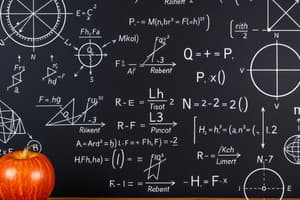Podcast
Questions and Answers
What is the main focus of geometry?
What is the main focus of geometry?
- Numbers and their operations
- Understanding changes and motion in functions
- Analyzing random events and likelihood of occurrences
- Studying shapes, sizes, and properties of space (correct)
Which statement accurately describes a function?
Which statement accurately describes a function?
- A relationship that assigns exactly one output for each input (correct)
- An equation representing two equal expressions
- A relationship where each input has multiple outputs
- An expression involving only numbers and symbols
Which of the following is an example of a rational number?
Which of the following is an example of a rational number?
- √2
- π
- 1/2 (correct)
- √3
What does the Pythagorean theorem relate to in geometry?
What does the Pythagorean theorem relate to in geometry?
Which of the following statements about calculus is correct?
Which of the following statements about calculus is correct?
In statistics, what is the mean?
In statistics, what is the mean?
What does the probability formula P(A) = Number of favorable outcomes / Total number of outcomes represent?
What does the probability formula P(A) = Number of favorable outcomes / Total number of outcomes represent?
Which option represents natural numbers?
Which option represents natural numbers?
Flashcards are hidden until you start studying
Study Notes
Overview of Mathematics
- Definition: The study of numbers, quantities, shapes, and patterns.
- Branches:
- Arithmetic: Basic operations (addition, subtraction, multiplication, division).
- Algebra: Use of symbols and letters to represent numbers and relationships.
- Geometry: Study of shapes, sizes, and properties of space.
- Trigonometry: Study of relationships between angles and sides of triangles.
- Calculus: Study of change and motion, involving derivatives and integrals.
- Statistics: Collection, analysis, interpretation, and presentation of data.
- Probability: Analysis of random events and likelihood of occurrences.
Fundamental Concepts
-
Numbers:
- Natural Numbers: Positive integers (1, 2, 3, ...).
- Whole Numbers: Natural numbers plus zero (0, 1, 2, ...).
- Integers: Whole numbers and their negatives (..., -2, -1, 0, 1, 2, ...).
- Rational Numbers: Numbers that can be expressed as fractions.
- Irrational Numbers: Numbers that cannot be expressed as simple fractions (e.g., π, √2).
-
Operations:
- Addition (+)
- Subtraction (−)
- Multiplication (×)
- Division (÷)
Algebra
- Expressions: Combinations of numbers and variables (e.g., 3x + 2).
- Equations: Statements that two expressions are equal (e.g., 2x + 3 = 7).
- Functions: Relationships between sets that assign exactly one output for each input (e.g., f(x) = x²).
Geometry
- Points, Lines, and Planes: Fundamental elements of geometry.
- Shapes:
- Polygons (triangles, quadrilaterals, etc.)
- Circles
- Theorems: Statements proven based on previously established statements (e.g., Pythagorean theorem).
Trigonometry
- Functions: Sine, cosine, tangent and their inverses.
- Identity: Sin²(x) + Cos²(x) = 1.
- Applications: Used in measuring angles, modeling periodic phenomena.
Calculus
- Limits: The value that a function approaches as the input approaches a point.
- Derivatives: Measure of how a function changes as its input changes (slope of tangent).
- Integrals: Measure of the area under a curve; reverse process of differentiation.
Statistics
- Descriptive Statistics: Summarizes and describes data (mean, median, mode).
- Inferential Statistics: Makes inferences and predictions about a population based on sample data.
Probability
- Events: Results of trials (e.g., flipping a coin).
- Probability Formula: P(A) = Number of favorable outcomes / Total number of outcomes.
- Law of Large Numbers: As trials increase, the experimental probability approaches the theoretical probability.
Applications of Mathematics
- Science and Engineering: Problem-solving and modeling physical systems.
- Finance: Calculating interest, investments, and risk assessment.
- Computer Science: Algorithms, data structures, and complexity.
Study Tips
- Practice problem-solving regularly.
- Understand concepts thoroughly rather than memorizing formulas.
- Visualize problems using diagrams or graphs.
- Relate mathematical concepts to real-world applications for better retention.
Overview of Mathematics
- Mathematics encompasses the study of numbers, quantities, shapes, and patterns.
- It has numerous branches including arithmetic, algebra, geometry, trigonometry, calculus, statistics, and probability.
Fundamental Concepts
- Numbers form the foundation of mathematics, with various classifications including:
- Natural numbers are positive integers starting from 1 (1, 2, 3, ...).
- Whole numbers include natural numbers plus zero (0, 1, 2, ...).
- Integers encompass both positive and negative whole numbers along with zero (..., -2, -1, 0, 1, 2, ...).
- Rational numbers can be expressed as fractions, while irrational numbers cannot be represented as simple fractions, such as π and √2.
- Operations are fundamental to manipulating numbers, including addition (+), subtraction (-), multiplication (×), and division (÷).
Algebra
- Expressions combine numbers and variables using operations (e.g., 3x + 2).
- Equations state that two expressions are equal (e.g., 2x + 3 = 7).
- Functions represent relationships between sets, assigning a unique output for each input (e.g., f(x) = x²).
Geometry
- Points, lines, and planes are fundamental elements of geometry, defining shapes and relationships in space.
- Shapes encompass polygons (like triangles and quadrilaterals) and circles.
- Theorems are proven statements in geometry, built on previously established facts (e.g., the Pythagorean theorem).
Trigonometry
- Trigonometric functions (sine, cosine, tangent, and their inverses) relate angles and sides of triangles.
- Trigonometric identity: Sin²(x) + Cos²(x) = 1.
- Applications: Trigonometry is used in measuring angles and modeling periodic phenomena.
Calculus
- Limits represent the value a function approaches as its input nears a specific point.
- Derivatives measure how a function changes as its input changes, representing the slope of the tangent line.
- Integrals calculate the area under a curve, representing the reverse process of differentiation.
Statistics
- Descriptive statistics summarizes and describes data using measures like mean, median, and mode.
- Inferential statistics draws inferences and predictions about a population based on sample data.
Probability
- Events represent possible outcomes of trials (e.g., flipping a coin).
- Probability formula: P(A) = number of favorable outcomes / total number of outcomes.
- Law of large numbers: As trials increase, the experimental probability approaches the theoretical probability.
Applications of Mathematics
- Science and engineering utilize mathematics for problem-solving and modeling physical systems.
- Finance relies on mathematics for calculating interest, investments, and risk assessment.
- Computer science uses mathematics for algorithms, data structures, and complexity analysis.
Study Tips
- Regular practice in problem solving is crucial.
- Focus on understanding concepts rather than rote memorization of formulas.
- Use diagrams and graphs to visualize problems.
- Connect mathematical concepts to real-world applications for better retention.
Studying That Suits You
Use AI to generate personalized quizzes and flashcards to suit your learning preferences.




